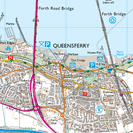National 4/5 Geography
Course Overview
Courses we cover in S4:
Urban
- characteristics of land-use zones in cities in the developed world
- recent developments in the CBD, inner city, rural/urban fringe in developed world cities Case study Edinburgh
Physical environments: Landscape types
The identification and formation of the following landscape features
- glaciated upland — corrie, truncated spur, pyramidal peak, arête, u-shaped valley
- coastal landscapes — cliffs, caves and arches, stacks, headlands and bays, spits and sand bars
Land uses in glaciated uplands and coastal landscapes:
farming
forestry
industry
recreation and tourism
water storage and supply
renewable energy
- the conflicts which can arise between land uses in a glaciated upland
- the solutions adopted to deal with the identified land use conflicts
Population
In the context of developed and developing countries:
- use of social and economic indicators
- physical and human factors influencing global population distribution
- factors affecting birth and death rates
Weather
Within the context of the United Kingdom:
- the effect of latitude, relief, aspect and distance from sea on local weather conditions
- the characteristics of the five main air masses affecting the UK
- the characteristics of weather associated with depressions and anticyclones
Rural:
- changes in the rural landscape in developed countries related to modern developments
in farming such as: diversification, impact of new technology, organic farming, genetic
modification, current government policy - changes in the rural landscape in developing countries related to modern developments
in farming such as: genetic modification, impact of new technology, biofuels
Map and graphical interpretation form a key component across all topic areas.
Methodology
Learning and teaching approaches are:
- Focused on the learner
- Enjoyable, relevant and inclusive – enhancing the
experience, achievement and attainment of all
young people - Active, allowing young people to become
problem solvers in a supportive and stimulating - Flexible and creative, allowing for personalisation of
learning - Allow for choice and challenge
- Collaborative and co-operative, promoting quality
social interaction between young people. - Using ICT to support digital literacy whilst enhancing the curriculum
Assessment
Evidence of progress and achievement will come from a variety of sources including:
- observing day-to-day learning within the classroom;
- coursework, including progress tests;
- learning conversations; and
- homestudy
- outcome assessments and prelim
Recording & Reporting
All pupil assessments are routinely graded and recorded by the teacher and the results are stored centrally, these results are used by staff to track the progress of the individuals and ensure that their needs are being met. Pupils also review their own attainment and are encouraged to identify ways to improve their learning. Staff report formally to parents as per the school calendar.
S4
Specific Home Study tasks will be distributed on a regular basis by individual class teachers. Homework will focus on exam practice and pupils will receive teacher or peer feedback. All homework will be posted on Teams.
After the prelim pupils will be given a 7-week rolling revision programme with sets of past paper questions to practice in preparation for exam. Submissions will be weekly and mandatory.
Assessment dates:
June: Progress test #1
October: Formal Assessment #2
January: Prelim
February: Assignment preparation and write-up (under exam conditions)
Resources
Resources will appear here soon.










